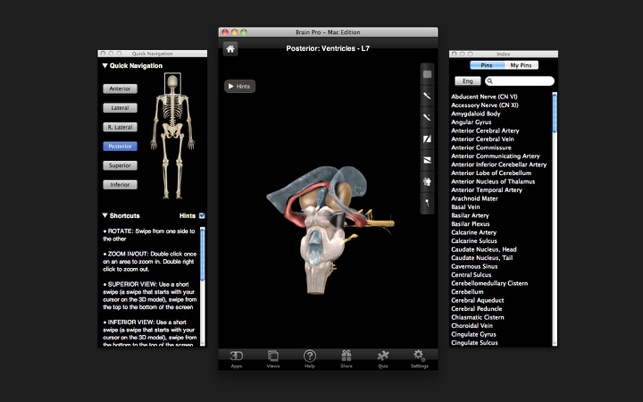The Brain Pro
The Brain Pro - Mac edition (Nova Series) has been designed specifically for the Mac. It is a must have app for anyone studying anatomy and is aimed at students with a basic to advanced level of anatomical medical knowledge as well as medical professionals. In this Nova Series the user can manipulate the Brain on screen by rotating it. TheBrain 8 is a free upgrade from TheBrain 7 if you have a Pro Combo subscription or if you purchased a Brain 7 license after July 15th, 2013. This is also described on our Upgrade Page. Our engineers are proactively fixing reported issues on a daily basis.
The Brain Project
1p36.22 Start 11,857,464 End 11,858,931 pattern Molecular function • • • • • Cellular component • • • Biological process • • • • • • • • • • • • • • • Sources: / Species Human Mouse n/a n/a n/a RefSeq (mRNA) n/a RefSeq (protein) n/a Location (UCSC) n/a search n/a Brain natriuretic peptide ( BNP), also known as B-type natriuretic peptide, is a secreted by in the in response to stretching caused by increased ventricular blood volume. BNP is named as such because it was originally identified in extracts of brain. Convert pdf to jpeg in windows 10. The 32-amino acid polypeptide BNP is secreted attached to a 76–amino acid fragment in the called (BNPT), which is biologically inactive. Once released, BNP binds to and activates the, and to a lesser extent, in a fashion similar to (ANP) but with 10-fold lower affinity. The of BNP, however, is twice as long as that of, and that of NT-proBNP is even longer, making these peptides better targets than ANP for diagnostic blood testing. The physiologic actions of BNP are similar to those of ANP and include decrease in and central venous pressure as well as an increase in.
The net effect of these peptides is a decrease in blood pressure due to the decrease in systemic vascular resistance and, thus, afterload. Additionally, the actions of both BNP and ANP result in a decrease in cardiac output due to an overall decrease in central venous pressure and preload as a result of the reduction in blood volume that follows natriuresis and diuresis.

The Brain Protocol
Contents • • • • • • • • • • • • • • • Biosynthesis [ ] BNP is synthesized as a 134-amino acid preprohormone (preproBNP), encoded by the human gene NPPB. Removal of the 25-residue N-terminal signal peptide generates the prohormone, proBNP, which is stored intracellularly as an O-linked; proBNP is subsequently cleaved between arginine-102 and serine-103 by a specific convertase (probably or ) into NT-proBNP and the biologically active 32-amino acid polypeptide BNP-32, which are secreted into the blood in equimolar amounts. Cleavage at other sites produces shorter BNP peptides with unknown biological activity. Processing of proBNP may be regulated by O-glycosylation of residues near the cleavage sites. Physiologic effects [ ] Since the actions of BNP are mediated via the ANP receptors, the physiologic effects of BNP are identical to those of ANP. Those will be reviewed here. Receptor- binding causes a reduction in, which results in a decreased blood volume.
Secondary effects may be an improvement in cardiac and reduction of systemic blood pressure. Is also increased.
Brain Pro Fast Forward
Renal [ ] • Dilates the afferent glomerular arteriole, constricts the efferent glomerular arteriole, and relaxes the. This increases pressure in the capillaries, thus increasing the (GFR), resulting in greater filter load of sodium and water. • Increases blood flow through the vasa recta, which will wash the solutes (NaCl and urea) out of the medullary interstitium. The lower osmolarity of the medullary interstitium leads to less reabsorption of tubular fluid and increased excretion. • Decreases sodium reabsorption in the (interaction with ) and of the via guanosine 3',5'-cyclic monophosphate () dependent phosphorylation of. • Its natriuretic effect is affected by and activity in vivo • Inhibits secretion, thereby inhibiting the. Adrenal [ ] • Reduces aldosterone secretion by the zona glomerulosa of the.
Latest News
- Pedro El Escamoso Novela Dvd
- Free Fonts Type In Words
- Get A Serial Number From Laptop
- Avengers 3 Full Movie 123movies
- Pes 10 Download Pc
- Spongebob The Movie Game Online
- Enrique Songs Free Download
- Rainbow Network Communications
- Ncert Books Pdf Hindi
- Nova Font Download
- Telugu Songs 2018
- The Next Pirates Of The Caribbean Movie
- Download Football Manager 2018 Pc
- Jadwal Siaran Tv Hari Ini
- Kasauti Zindagi Ki 2 Online
- Gambino New Song
- Pirates Of The Caribbean 6 Release Date